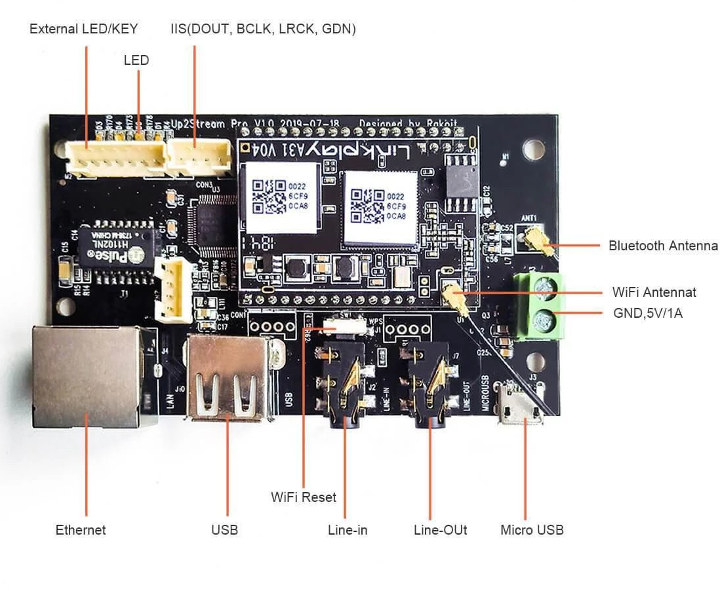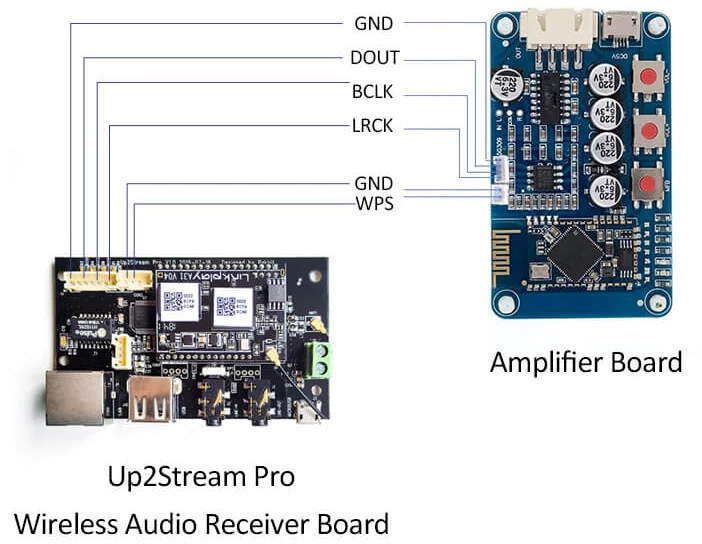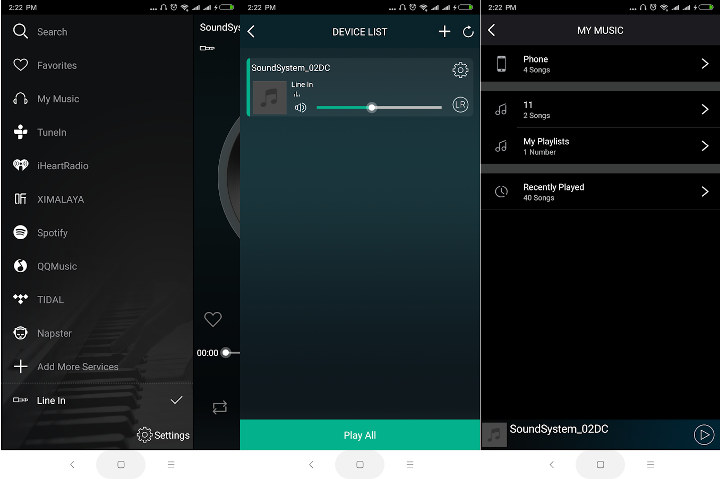Last December, we wrote about Up2Stream WiFi audio module designed for people wanting to build their own DIY wireless speakers. The module is based on MediaTek MT7688AN MIPS processor with 64MB DDR2 and 16MB flash storage
The module also comes with a small baseboard allowing for an easier connection to speakers. The company has now introduced Up2Stream Pro model based on the same module, but with a baseboard adding more features including Bluetooth, Ethernet, USB, and audio jacks.

Up2Stream Pro key features and specifications:
- Audio
- Output – 3.5mm AUX jack and I2S header
- Input – 3.5mm AUX-in
- SNR: 91db
- THD: 0.03%
- Sample rate – 24bit up to 192kHz
- FLAC, Wav, and APE codec supported, but NOT SBC, APT-X, APT-X HD, or LDAC.
- Multiroom & Multizone support
- EQ control
- Connectivity – Ethernet, WiFi, and Bluetooth 5.0
- Streaming
- Protocols – Airplay, DLNA, UPnP, Spotify Connect
- Compatible Services – Spotify, Deezer, Tidal, Qobuz, Napster, iHeartRadio.
- Local Streaming from NAS or USB
- USB – 1x USB 2.0 port, 1x micro USB port
- Misc – External LED/key header
- Power supply – 5V/1A via micro USB port or 2-pin terminal block
- Dimensions – 85 x 50mm

As noted last year, this is mostly a DIY hardware convertion kit, and the company does not provide the source code for the firmware because the “multiroom streaming software is quite complicated to implement reliably”. The board can be controlled from 4STREAM app available for Android and iOS, and they also have an API to control the volume.

The board is available now for $49.99 on Amazon. You may also find additional information on the product page.

Jean-Luc started CNX Software in 2010 as a part-time endeavor, before quitting his job as a software engineering manager, and starting to write daily news, and reviews full time later in 2011.
Support CNX Software! Donate via cryptocurrencies, become a Patron on Patreon, or purchase goods on Amazon or Aliexpress





the company does not provide the source code because the “multiroom streaming software is quite complicated to implement reliably”.
That is by far the most BS argument I heard for not disclosing source code.
If it is just because it is complicated that would be a good reason to publish (so others might learn from it or spot flaws).
This thing also seems overpriced.
Exactly. Selling dev board without source code, such a clever idea 🙂
https://www.sonos.com/en-us/shop/port.html
SONOS PORT $399 ,check and compare 🙂
not really a comparison.
Sonos is a device not a board, so it also has a housing, power supply etc etc.
And with Sonos half of your money is just for the brand.
Actually the streaming part could probably done more efficient on even an RPI zero (also more memory and flash, heck 16M flash, 64M ram. The average router has more)
And if you want audio in and out either add a hat for it, or use a usb audio adapter
PS: my expectation of the BOM cost of this Sonos thing would be $ 50 at most.
Can your system do multiroom control in app ? Do your app support streaming Tidal, Qobuz, Spotify Connect, Tune in, Deezer ? Does your system support all sources, such as line in re stream to all other unit and play in sync ? And Alexa control update soon, amazon music updates soon.?
And API for smart home integration ?
Yes, can easily run snapcast on a Pi Zero for multiroom audio with AirPlay & Spotify etc.
as soon as I saw Mediatek, I knew source wouldn’t be included.
>FLAC, Wav, and APE codec supported, but NOT SBC, APT-X, APT-X HD, or LDAC.
Eh? What’s Bluetooth there’s for then?
In their FAQ they explain they could support those but with another chip that costs more.
SBC is the default Bluetooth A2DP codec. If they don’t have SBC, I suppose they don’t support audio over Bluetooth? Why do they have Bluetooth hardware then?